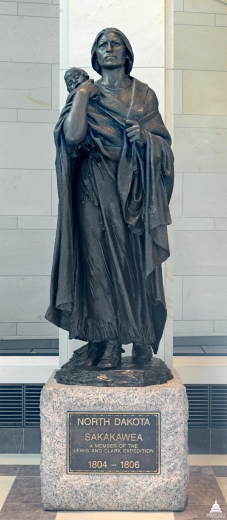
Explore Capitol Hill
Bronze
Given by North Dakota in 2003
Emancipation Hall
U.S. Capitol Visitor Center
This statue of Sakakawea was given to the National Statuary Hall Collection by North Dakota in 2003. The eight-foot-high bronze statue depicts Sakakawea looking westward, with her infant son strapped on her back.
In 1800, at about the age of 12, a Shoshone girl was captured by the Hidatsa tribe in an area that is now North Dakota. Her original name is not known, but she was given a new name by her captors. The State of North Dakota has adopted Sakakawea as the most accurate English representation of this name, which means “Bird Woman,” although other spellings (e.g., Sacagawea and Sacajawea) are also used.
By 1804 Sakakawea had become the wife of a French-Canadian, Pierre Charbonneau, who was hired in that year as an interpreter for the northwest expedition headed by Meriwether Lewis and William Clark. She traveled with the party and assisted with translation and made contacts with Shoshone and Hidatsa people, who considered the presence of a woman a sign that the expedition was peaceful. She served as a guide and gathered edible plants along the route. Her son Jean Baptiste was born on February 11, 1805, in winter quarters at Fort Mandan in North Dakota, and she carried him with her when travel resumed. After the return of the expedition in 1806, Sakakawea and her husband and son lived in the Mandan and Hidatsa villages. She is believed to have died of a fever in 1812 at Fort Manuel near Kenel, South Dakota.
In selecting Sakakawea as the subject of this statue, the state legislature chose to honor her as a “traveler and guide, a translator, a diplomat, and a wife and mother” and to recognize that “her indomitable spirit was a decided factor in the success of Lewis and Clark’s...expedition.” Their choice appears to agree with the sentiment expressed by William Clark in a letter to Sakakawea’s husband almost two centuries ago: “your woman who accompanied you that long dangerous and fatiguing rout to the Pacific Ocean and back deserved a greater reward for her attention and services on that rout than we had in our power to give her.” The statue was in place in the Capitol for the beginning of the bicentennial of the Lewis and Clark Expedition.
The statue is a replica of one dedicated in 1910 on the grounds of the state capitol in Bismarck at the entrance to the North Dakota Heritage Center. The statue is by Leonard Crunelle (1872–1944), who was born in France and emigrated to United States in 1882. He worked in mines in Illinois until 1893, when he became a student and apprentice of sculptor Lorado Taft in Chicago. His model for Sakakawea was her granddaughter, Mink Woman, from the Fort Berthold Indian Reservation in North Dakota. The General Federation of Women’s Clubs of North Dakota raised funds for the replica, as they did for the original statue. The replica was cast by Arizona Bronze Atelier, whose owner is a Bismarck native. It weighs 875 pounds and stands on a granite pedestal weighing over two tons. The replica was displayed in North Dakota before it was transported to Washington, D.C.









